In the course of thirty years or less since the first tracks were laid, dining cars appeared on the western frontier railroads.. Thirty years is not necessarily a short time span but the changes that occurred in the American West and it’s railroads during this period were absolutely astounding.
Thank you for reading this post, don't forget to subscribe!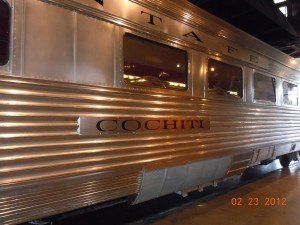
The period from about 1850 and the end of the nineteenth century saw some of the most dramatic changes in railroad travel, particularly travel in the western United States. One of those changes was the introduction of the dining car. People today are still able to enjoy railroad dining whether on Amtrak cross country trains or scenic tourist railroads with their one day adventures. It’s a way to experience a piece of American history from the days of great national expansion when the railroad meant everything for a town to grow and prosper.
The Atchison Topeka & Santa Fe Railroad Dining Cars
Fred Harvey and the Atchison Topeka & Santa Fe Railroad were legendary for their top quality service. Fred Harvey was so successful in managing the AT & SF rail side eateries and hotels that the railroad asked him to put his magic to work on their planned dining cars. To Fred Harvey, this was not ideal. Harvey initially didn’t feel that the same level of quality could be served up on a moving train car.
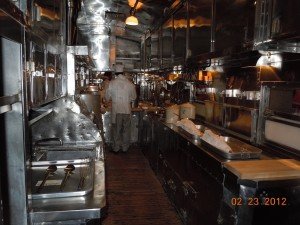
Since the 1880’s, dining cars became standard offerings on cross country trains heading west from Chicago. The AT& SF relied on the string of Harvey Houses along it’s route. In fact, these Harvey Houses were strategically located to accommodate passengers during meal hours.
To put this in some perspective, railroads without the Fred Harvey eateries along their route put their passengers through quite an ordeal. At a stop, railroad passengers might have had up to one hour to find the nearest roadhouse to the train tracks and hope for the best. Unfortunately, the best sometimes wasn’t good. The fact that there was enormous room for improvement is what gave Fred Harvey his early inspiration.
The Fred Harvey customers usually were aware of one trademark of the Harvey dining rooms. Harvey’s meals were served in sumptuous portions that provided a good value for the traveling public. All of a sudden railroad dining reached a new higher level. Top quality food and service and the AT& SF naturally scenic train routes were a winning combination.
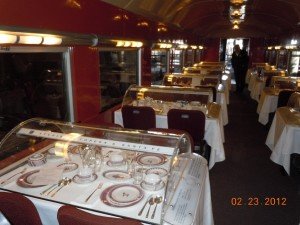
Those wanting to get a hold of some of the old Harvey House recipes might look for the book, The Harvey House Cookbook by George H. Foster. The book includes vintage recipes from the various Harvey Houses and the AT & SF railway cars. The book includes over 200 recipes.
Pictured in this article is the 36 seat “Cochiti” dining car of the Achison Topeka& Santa Fe Railroad.
This rail car was a new streamlined stainless steel car that was part of the railroad’s famous “Super Chief” train that offered once a week service between Chicago Illinois and Los Angeles California.
This dining car and seven others were ordered by the railroad in 1936. All of the AT&SF cars were named after Native Indian tribes. The Cochiti was named after the Indian pueblo of Cochiti about thirty miles southwest of Santa Fe New Mexico. This is also a good destination to add to your New Mexico vacation planner.
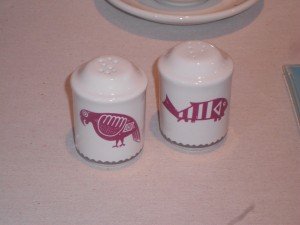
The Cochiti Dining Car On Display
The Cochiti dining car has been preserved and is on display at the famous California State Railroad Museum located in Old Town Sacramento California. When you explore the interior of this dining car you can view the kitchen area and all the tables have been set with china and silverware. This is one of the most authentic rail car displays you’ll come across. This particular dining car has been set to it’s mid 1940’s condition. If your travels take you to Sacramento California you’ll want to add a stop at Old Town and the California State Railroad Museum to your trip planner.
Railroad dining cars today are quite different than the earlier cars in basic design. The Cochiti dining car was a one level rail car where the kitchen area was on one end of the car with the dining tables occupying the remainder. You might have a kitchen area with bar stools and then the table beyond. On today’s Amtrak bi-level rail cars, you have the dining booths taking up most of the upper level with the kitchen area being on the lower level. Food is sent up via a dumbwaiter.
See the Trips Into History articles on the links below…
The Legendary Union Pacific Big Boy Locomotive
Historic Steam Locomotive Exhibits
Also, see our Western Trips article and visit to a restored Pullman Rail Car…
The Pullman Car and What It Did For Travel
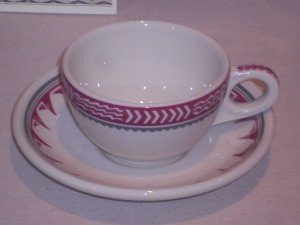
View Santa Fe Railroad Dining Car Fine China
If your travels take you to the Dallas/Fort Worth Texas region you’ll find an excellent railroad museum with terrific exhibits in Frisco Texas, a northern suburb of Dallas.
The founding of Frisco Texas, it’s strong connection with the Misouiri, Kansas and Texas Railroad, the MKT, and life in an early frontier environment is all presented in fine detail at the Frisco Heritage Museum. You’ll also see a good collection of railroad dining car china including china from the Santa Fe Railroad. The original railroad china was made available to the public in two sales held in 1971.
Among their collections is china that was used on the Santa Fe Railroad’s “Super Chief ” dining cars. During railroad’s golden years, most railroads had their own distinctive designs used on everything from plates, cups, towels, playing cards and just about anything the passenger would regularly use. The Pullman cars which usually operated as a franchise managed by the Pullman Palace Car Company also had their names and logos on many items.
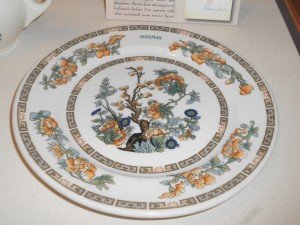
The Santa Fe Railroad adopted the southwest and Indian cultures as a major way the rest of the country would view their railroad. This was also included on the designs for their dining car china.
This type of china was used on AT & SF Railroad dining cars right up until passenger service was discontinued in 1971.The china featured in this article was produced exclusively for the AT & SF Railroad from 1936 to 1970 by the Onandaga Pottery Company. Today, authentic pieces like the ones displayed here are considered quite rare.
Original railroad dining car china is a popular artifact for collectors. Today, reproductions which claim the same high quality are offered by several companies. Collectors would want to verify production methods, etc before purchasing any reproduction china.
(Article and photos copyright Trips Into History)
